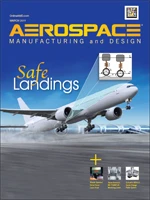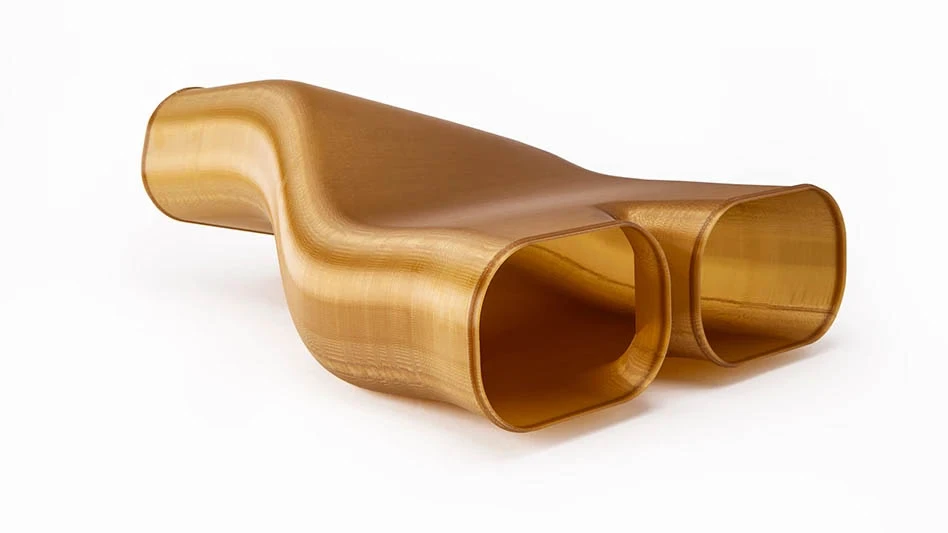Conventional metalcutting tooling is still widely used in machining of composites and could be detrimental to productivity and product quality. Pioneering research and development through the partnership of Airbus in the United Kingdom and precision tool specialists SGS Carbide Tool (U.K.), is delivering substantial benefits in understanding the most effective machining strategy of aerospace grade carbon fiber reinforced plastics (CFRP) composites for primary aircraft structures. The breakthrough has elevated both parties to the forefront of knowledge in composite machining.
 Figure 2: Shown above is the test setup used by Airbus in the United Kingdom.The Study
Figure 2: Shown above is the test setup used by Airbus in the United Kingdom.The Study
A recent case study was carried out by SGS with the Manufacturing Engineering Research department of Airbus Wing Centre of Excellence (CoE) in Bristol,UK. The objective was to evaluate and optimize the machining strategy before production of composite components.
SGS first introduced a purpose-designed CFRP composite cutting tool to Airbus in early 2008. Early test results did not provide any benefits compared to baseline PCD tooling. After introducing a number of modifications to the existing design, and optimization of machining conditions, significant improvements in productivity, surface quality, and tool life were achieved. Further benchmark testing has shown that the redesigned router outperformed PCD tooling in a number of instances when machining CFRP composites.
The Airbus trails have also enabled SGS to develop its carbon composite router through real-life test analysis.
“The Airbus collaboration has accelerated the tool’s development significantly, and we have been developing special derivatives of the tools to test, which is to all our customers’ benefit in time. The results have been extremely beneficial both to us and to Airbus in generating a greater understanding of the most effective methods of machining CFRP composites,” states Wesley Tonks, field sales manager, SGS.
 Figure 3: The graph above indicates the benchmark for different cutting tool designs.Breakthrough
Figure 3: The graph above indicates the benchmark for different cutting tool designs.Breakthrough
Wei-Ming Sim confirmed that SGS tooling significantly outperformed PCD equivalents in the controlled tests conducted, while returning double the tool life. At the same time, they reduced delamination of the top and bottom of the composite laminates. The tool is also far more progressive in performance, giving a warning when performance is nearing a drop-off as the tool wears.
“As further testing progressed, in harmony with further tool development, we have been able to cut deeper with our specially-developed long shank tools while maintaining consistently high quality results, Tonks continues. “However, the issue that become more critical to effective carbon composite machining in these circumstances is the effective removal of waste material to reduce the tendency of the ultra-fine swarf to clog.”
This has triggered additional research with Airbus’ machine tool suppliers, to investigate and create an effective low-pressure zone/vacuum around the tool to remove dust most efficiently on the 5-axis MTorres TorresMill gantry machining center.
Research
The research has taken 24 months to fully understand the fundamentals of composite machining. The focus of this research is the milling of CFRP composites, commonly known as routing. The starting point is to review the industrial state-of-the-art composite machining. The review focuses on the work carried out by some of the major players in the aerospace industry, such as BAE Systems, Boeing, and GKN Aerospace. At that time, polycrystalline diamond (PCD) tooling was commonly used in the industry. A number of leading PCD tooling suppliers were contacted and these cutting tools were tested on the baseline CFRP materials, which would be used for the A350 XWB aircraft.
 Figure 5: Tool life comparison chart for the different cutting tool configurations.
Figure 5: Tool life comparison chart for the different cutting tool configurations.
Test protocol
Slotting was chosen as this was the most demanding operation due to the deployment of up and down milling in one revolution cut, with a tendency of clogging in the slot. The test criteria include uncut fibers on the top/bottom ply, onset of vibration, and residual of dust in the slot.
A typical test condition is as follows:
- Tool diameter, Dc = 12mm;
- Radial depth of cut, ae = 12mm
- Axial depth of cut, ap = 5mm
- Cutting speed, vc and feed/tooth, fz = varied
All tests were performed dry on the 5-axis Mtorres, TorresMill gantry machining centers as shown in Figure 1. The TorresMill has a high speed spindle of up to 35,000rpm and is equipped with a vacuum to enable the dry machining of composites.
Further in-depth testing to characterize the cutting tool quantitatively includes cutting conditions (vc and fz) optimization, cutting force measurement, tool wear analysis, workpiece analysis, and tool life testing.
Figure 2 shows the test setup used at the Airbus facility in the United Kingdom, while Figure 3 shows the typical benchmark plot from testings.
Knowledge-base
The following information obtained in the research of the CCR series during the last 24 months includes:
- The choice of cutting speed was critical, as it affects the wear mechanism. Two dominant wear mechanisms observed are abrasive wear and chipping. High cutting speeds lead to a premature failure, or chipping of the CCR-series cutting edge.
- High cutting conditions lead to a high cutting temperature at the cutting tool, and on the workpiece material contact area of the workpiece. Therefore, the composite dust generated has a greater tendency to bind, leading to clogging at the cutting edge and smearing on the fiber-matrix. Figure 4 shows the scanning electron microscope (SEM), pictures of the fibre-matrix are at a magnification of 250.
- Coating appears to have a negative effect on the cutting edge on CCR series cutting tool. Figure 5 shows an extended tool life for the uncoated CCR cutting tool as compared to the coated version and PCD.
- The design of the CCR-series lead to no obvious uncut fibers on the top or bottom ply. As the tool wear increases, the amount of uncut fibers also increases.
SGS North America
Rutherford, NJ
us.sgs.com
This features is authored through the collaboration of the following: Wei-Ming Sim & Ashley Moran (Airbus); Eike Hasselberg (University of Hannover); Alan Pearce & Wesley Tonks (SGS Carbide Tool (UK))

Explore the March April 2011 Issue
Check out more from this issue and find your next story to read.
Latest from Aerospace Manufacturing and Design
- NASA selects instruments for Artemis lunar terrain vehicle
- Twin-cutter boring head
- Bell awarded funding for X-plane build phase of SPRINT program
- Shaft coupling clamps
- #46 Lunch + Learn Podcast with SMW Autoblok
- Gleason Corp. acquires the Intra Group of Companies
- Thread milling cutter reduces cutting pressure, vibration
- Malaysia Aviation Group orders 20 more Airbus A330neo widebodies





